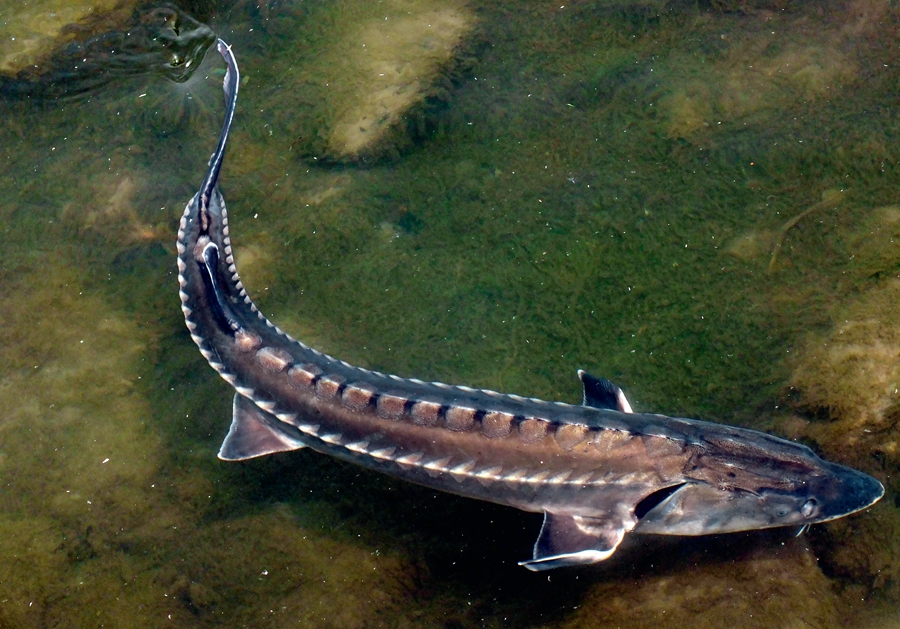AMONG all 27 species of sturgeon in the world, Chinese sturgeon has the lowest latitude distribution, it mainly inhabits the Yangtze River and the continental shelves of the South and East China Seas. Some are also found in the Ganjiang, Xiangjiang, Minjiang, Qiantang, and the Pearl rivers in China. In 1836, British zoologist John Edward Gray came across a sturgeon specimen from Macao, and realized that it was a brand new species. Since it was discovered in China, Gray named it Acipenser sinensis, in which sinensis is Latin for China.

Chinese sturgeon is a typical anadromous species, spending most of its life in salt water and returning to fresh water to breed. Every year, during July and August, the breeding sturgeon migrates from the estuary of the Yangtze River upstream and complete gonad development there. Between October and November of the following year, they travel to a specific area in the upper and middle reaches of the Yangtze River to spawn. The female sturgeon leaves right after the spawn while the male stays until the end of the breeding season.
After the eggs hatch, the baby sturgeons swim to the surface of the water and drifts along the currents. Three to seven days later, they dive to forage for food at the bottom of the river and stay in deep grooves there for the winter. The baby sturgeon can be found at the estuary of the Yangtze River between April and October in the next year, where they pass their adaptive phase. They are ready to enter the ocean when their length exceeds 30 cm. The total migration and breeding cycle takes 18 months, covering around 3,000 km, the longest among all the anadromous fishes in the Yangtze River.
Chinese sturgeon dates back to the Cretaceous period, and is known as a member of the Chondrostei group, a transition between Chondrichthyes and Osteichthyes. The ancient fish has a sturdy and elongated body, acuminated but bluntly pointed snout and four barbels which descend from the snout near the front of the mouth. There are plum blossom shaped patterns on the snout of the sturgeon while its body is covered with five rows of thick bony scutes, one on the back, two on each side. The number of scutes differs among individuals. Normally, there are 12-14 big ones loosely arranged on the back.
Chinese sturgeon grow fast, and can reach enormous sizes. The one-year-old’s in cultivations weigh around two kg, while wild ones gain eight to 14.5 kg by average every year. An average matured male sturgeon is 250 cm long and weighs 150 kg while the female reaches 400 cm long and weighs more than 350 kg. The largest ever found is 700 kg.
The bottom of the rivers and seas is the main area inhabited by Chinese sturgeon. Baby sturgeons feed on plants and invertebrates under water. Having a sharp sense of smell like a dog, Chinese sturgeon are experts in hunting for small fish and shells hidden in sand.
Chinese sturgeon can live as long as 50 years. However they mature quite late, 11 years for the male and 14 years for the female, and they only spawn every three to five years. What makes the case even worse is that the survival rate is very low.
In 1988, Chinese sturgeon was listed among the first-class protected animals in China. In 1997, it was recognized as an endangered species by the Convention on International Trade in Endangered Species (CITES). And in 2010, it entered the International Union for Conservation of Nature (IUCN) Red List of Critically Endangered Species.
In China, artificial breeding of Chinese sturgeon has been in operation, with more than six million fry released into the Yangtze River so far. However, the number of wild Chinese sturgeon capable of breeding is less than 100. The rarity of Chinese sturgeon gained the fish a nickname — aquatic panda.
The Chinese government has been working on saving the indigenous sturgeon since the 1970s. At that time, there were thousands of sturgeon in the Yangtze River, more than 19 spawning grounds in the lower Jinsha River and the upper reaches of the Yangtze River. However, water conservancy projects, overfishing, pollution, and heavy shipping traffic have pushed the species to the verge of extinction.
Entering the new century, the government imposed a seasonal fishing ban in the Yangtze River and a permanent fishing ban for wild Chinese sturgeon, along with campaigns for raising people’s awareness for their protection. After absence of signs of natural breeding for two years, in 2015, baby Chinese sturgeon were discovered once again in the estuary of the Yangtze River, which indicates the sturgeon have found their new spawning grounds. In September 2017, an adult wild Chinese sturgeon about 180 cm in length and weighing around 100 kg was found upstream of the Yangtze River. Luckily, this giant creature wasn’t hurt in the process of being caught, and was immediately released back into the water.
JIANG FUMEI is a Beijing-based freelancer.